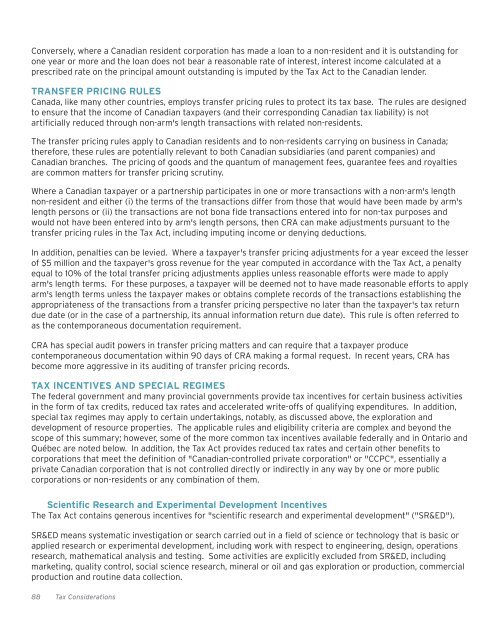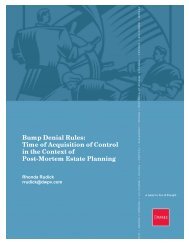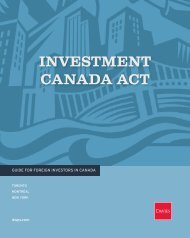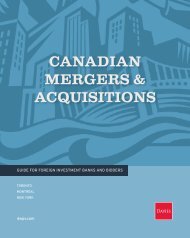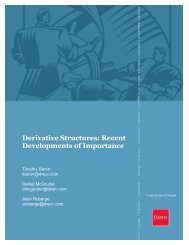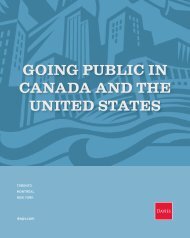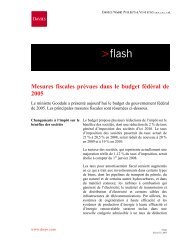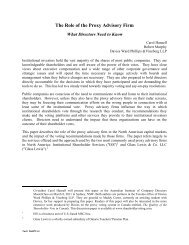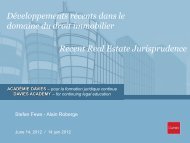doing business in canada - Davies Ward Phillips & Vineberg LLP
doing business in canada - Davies Ward Phillips & Vineberg LLP
doing business in canada - Davies Ward Phillips & Vineberg LLP
- No tags were found...
Create successful ePaper yourself
Turn your PDF publications into a flip-book with our unique Google optimized e-Paper software.
Conversely, where a Canadian resident corporation has made a loan to a non-resident and it is outstand<strong>in</strong>g forone year or more and the loan does not bear a reasonable rate of <strong>in</strong>terest, <strong>in</strong>terest <strong>in</strong>come calculated at aprescribed rate on the pr<strong>in</strong>cipal amount outstand<strong>in</strong>g is imputed by the Tax Act to the Canadian lender.TRANSFER PRICING RULESCanada, like many other countries, employs transfer pric<strong>in</strong>g rules to protect its tax base. The rules are designedto ensure that the <strong>in</strong>come of Canadian taxpayers (and their correspond<strong>in</strong>g Canadian tax liability) is notartificially reduced through non-arm's length transactions with related non-residents.The transfer pric<strong>in</strong>g rules apply to Canadian residents and to non-residents carry<strong>in</strong>g on <strong>bus<strong>in</strong>ess</strong> <strong>in</strong> Canada;therefore, these rules are potentially relevant to both Canadian subsidiaries (and parent companies) andCanadian branches. The pric<strong>in</strong>g of goods and the quantum of management fees, guarantee fees and royaltiesare common matters for transfer pric<strong>in</strong>g scrut<strong>in</strong>y.Where a Canadian taxpayer or a partnership participates <strong>in</strong> one or more transactions with a non-arm's lengthnon-resident and either (i) the terms of the transactions differ from those that would have been made by arm'slength persons or (ii) the transactions are not bona fide transactions entered <strong>in</strong>to for non-tax purposes andwould not have been entered <strong>in</strong>to by arm's length persons, then CRA can make adjustments pursuant to thetransfer pric<strong>in</strong>g rules <strong>in</strong> the Tax Act, <strong>in</strong>clud<strong>in</strong>g imput<strong>in</strong>g <strong>in</strong>come or deny<strong>in</strong>g deductions.In addition, penalties can be levied. Where a taxpayer's transfer pric<strong>in</strong>g adjustments for a year exceed the lesserof $5 million and the taxpayer's gross revenue for the year computed <strong>in</strong> accordance with the Tax Act, a penaltyequal to 10% of the total transfer pric<strong>in</strong>g adjustments applies unless reasonable efforts were made to applyarm's length terms. For these purposes, a taxpayer will be deemed not to have made reasonable efforts to applyarm's length terms unless the taxpayer makes or obta<strong>in</strong>s complete records of the transactions establish<strong>in</strong>g theappropriateness of the transactions from a transfer pric<strong>in</strong>g perspective no later than the taxpayer's tax returndue date (or <strong>in</strong> the case of a partnership, its annual <strong>in</strong>formation return due date). This rule is often referred toas the contemporaneous documentation requirement.CRA has special audit powers <strong>in</strong> transfer pric<strong>in</strong>g matters and can require that a taxpayer producecontemporaneous documentation with<strong>in</strong> 90 days of CRA mak<strong>in</strong>g a formal request. In recent years, CRA hasbecome more aggressive <strong>in</strong> its audit<strong>in</strong>g of transfer pric<strong>in</strong>g records.TAX INCENTIVES AND SPECIAL REGIMESThe federal government and many prov<strong>in</strong>cial governments provide tax <strong>in</strong>centives for certa<strong>in</strong> <strong>bus<strong>in</strong>ess</strong> activities<strong>in</strong> the form of tax credits, reduced tax rates and accelerated write-offs of qualify<strong>in</strong>g expenditures. In addition,special tax regimes may apply to certa<strong>in</strong> undertak<strong>in</strong>gs, notably, as discussed above, the exploration anddevelopment of resource properties. The applicable rules and eligibility criteria are complex and beyond thescope of this summary; however, some of the more common tax <strong>in</strong>centives available federally and <strong>in</strong> Ontario andQuébec are noted below. In addition, the Tax Act provides reduced tax rates and certa<strong>in</strong> other benefits tocorporations that meet the def<strong>in</strong>ition of "Canadian-controlled private corporation" or "CCPC", essentially aprivate Canadian corporation that is not controlled directly or <strong>in</strong>directly <strong>in</strong> any way by one or more publiccorporations or non-residents or any comb<strong>in</strong>ation of them.Scientific Research and Experimental Development IncentivesThe Tax Act conta<strong>in</strong>s generous <strong>in</strong>centives for "scientific research and experimental development" ("SR&ED").SR&ED means systematic <strong>in</strong>vestigation or search carried out <strong>in</strong> a field of science or technology that is basic orapplied research or experimental development, <strong>in</strong>clud<strong>in</strong>g work with respect to eng<strong>in</strong>eer<strong>in</strong>g, design, operationsresearch, mathematical analysis and test<strong>in</strong>g. Some activities are explicitly excluded from SR&ED, <strong>in</strong>clud<strong>in</strong>gmarket<strong>in</strong>g, quality control, social science research, m<strong>in</strong>eral or oil and gas exploration or production, commercialproduction and rout<strong>in</strong>e data collection.88 Tax Considerations


